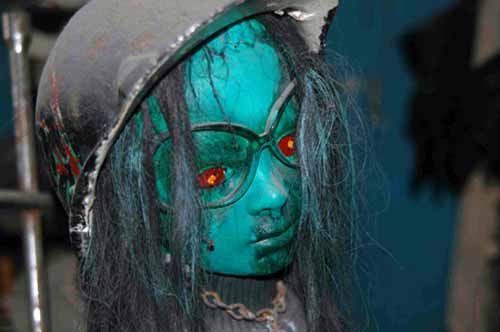 Highland Park • Pittsburgh, PA 15206 • 1-412-661-1498 macondo@telerama.com SINCE 1974 |
|||||||||||||||||||||||||||||||||||||
|
The Artists of the Grand Rue
Musee d'Art An urban museum in Port-au-Prince, Haiti |
|||||||||||||||||||||||||||||||||||||
|
To skip the history and go directly to the photos, click here
************************************************ |
|||||||||||||||||||||||||||||||||||||
 |
|||||||||||||||||||||||||||||||||||||
| The Welcoming Committee. Photo by Bill Bollendorf 2005. | |||||||||||||||||||||||||||||||||||||
|
March 2005. The mood in Haiti is grim. Kidnappings, murder, and mayhem dominate every conversation and dingy white UN tanks troll the streets of downtown Port-au-Prince. But in the neighborhood of Grand Rue on the western end of the Boulevard JJ Dessalines, something intensely positive and creative has been developing for years.
••••••••••••••••••••••••••••••••••••••••••••••••••••••••••••••• Up an alley off the Grand Rue, a massive figure towers over the squat cinderblock houses. The alley leads to an open lot populated with a macabre choir of effigies- life sized and larger-than-life constructs- all made from junk: rusted auto frames, truck springs, tires, shock absorbers, steering wheels, universal joints, oil filters, brake drums, and all manner of metal and plastic debris. Some of the figures have carved wooden features, others are fitted with plastic doll heads and many are topped with human skulls. There are faces made from gas tanks and oil pans, the features pounded in with hammers or with cut-out eyes and mouths. A closer look reveals the colossus to be Baron Samedi, the Vodou God of the Cemetery with his trademark top hat, and smoking a pipe. He sports a huge penis; its shaft a heavy spring, its carved wooden head painted red with teeth bared in a menacing smile. Bossou is there too, his horns made from bicycle handlebars, while Cousin Zaca, loa of agriculture, stands in a faded formal blue cutaway jacket and red neck scarf. A short way past the lot is Eugene's atelier, a roofless cinderblock room containing a myriad of smaller pieces including some that combine painted wood, metal, and human bones which, he says, are readily available in Haitian cemeteries. His calling card says, "E Pluribus Unum, Musee d'Art", so named because the artists use a diverse selection of materials to achieve a unified composition. From many, one. |
|||||||||||||||||||||||||||||||||||||
 |
|||||||||||||||||||||||||||||||||||||
| "Erzuli" by Guyodo. photo © Bill Bollendorf 2005 | |||||||||||||||||||||||||||||||||||||
| Deeper in the block, along narrow pathways lined with densely-packed houses and worn smooth by thousands of feet, is the domain of Guyodo, a laid back young man in dark shades. His atelier is a small building with a brightly painted door. There is no light inside but apparently the room is packed to capacity with figures large and small. The flash of a camera strobe momentarily reveals the individual personalities of the hundreds of icons that inhabit the space. They stand on the floor, cover the walls and hang from the beamed ceiling. Every square inch of space is occupied. There are scores of small sheet metal figures, some painted. There are creatures with oil filters for heads and radiator hoses for arms, legs and phalluses. As one's eyes become accustomed to the darkness, a figure with long black hair, a verdigris face and bright red eyes emerges. "Ezili Freda" says Guyodo, smiling broadly. The atmosphere inside the room, is intense and seductive. | |||||||||||||||||||||||||||||||||||||
 |
|||||||||||||||||||||||||||||||||||||
| Atelier Celeur. Photo©Bill Bollendorf 2005 | |||||||||||||||||||||||||||||||||||||
| Further on is the territory of Celeur, a trim young man with intelligent eyes and an understated smile. His depot is as crowded as Guyodo's but there is more light thanks to a couple of small windows. His figures tend to be larger and many are carved of wood decorated with nails and metal sheeting, some with hubcap halos. Most of them have an oversized phallus, a characteristic common to Vodou iconography, which signifies strength and power, spiritual and sexual. He also does eerily delicate paintings, reminiscent of Edvard Munch, on inside-out truck tires. Celeur holds up some plywood-mounted mask constructions made from bike tires finished with metallic paint and inlaid mirrors.
The work of Eugene, Celeur and Guyodo was included in the illuminating survey of Haitian sculpture, "Lespri Endependan," at the Frost Museum at Florida International University in 2004. There is an excellent catalog of that show. As museum experiences go, a visit to the "Grand Rue" is memorable. The neighborhood is infused with the air of enchanting paradox that makes Haiti so unique. The sculpture colony would be foreboding were it not for the crisscrossing clotheslines of colorful wash drying in the sun and the people going about their lives: a toddler carries her baby doll, young boys kick a soccer ball, teenage girls braid one another's hair and women squat to wash their dishes in basins of soapy water. Nearby you can hear the whine of power saws, sanders and drills. It's an industrious neighborhood of auto repair shops, junkyards and wooden handicraft workers. The positive energy here is palpable, supercharged by the noble art of upcycling, as the mundane is morphed into the magical. For a slide show of some of the highlights, click here. ••••••••••••••••••••••••••••••••••••••••••••••••••• To view some work by Guyodo that is for sale, Click here. •••••••••••••••••••••••••••••••••••••••••••••••••••••••••••••••• Visit the website of the Artists of the Gran Rue ••••••••••••••••••••• July 2009 Guyodo has his own website March 2005. Thanks to Donald Cosentino for turning me on to the place |
|||||||||||||||||||||||||||||||||||||
 |
 |
 |
 |
 |
 |
||||||||||||||||||||||||||||||||
|
|||||||||||||||||||||||||||||||||||||